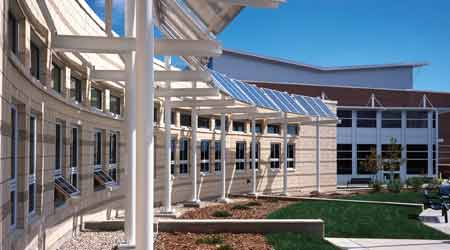
Creating an environment that protects student health and supports a more sustainable future
At the Center for Green Schools at U.S. Green Building Council (USGBC), we know that where we learn matters. From the air students’ breathe to the lighting in a room, the learning environment has a tremendous impact on children’s health and education. That’s why the Center has made it its mission to put every child in a green school within this generation.
A green school is much more than just a school building; it is an environment that encourages and enriches learning, protects student health and supports a more sustainable future. A green school can be defined within a three pillar framework — minimized environmental impact, improved occupant health, and effective sustainability and environmental literacy for all graduates. The three pillars act as a simple, organizing principle for educational institutions as they journey toward whole-school sustainability.
This definition unites the education, health and environmental communities in a global, green schools movement. In fact, this framework has been broadly adopted both in the U.S. and internationally, and is the basis of the Department of Education’s Green Ribbon Schools program.
Growth In Green
With increased awareness of sensitivities to chemicals, green cleaning has become of a major focus for schools.
Since 2006, 10 states and Washington, D.C. have implemented laws that address green cleaning in schools. But while there has been an increasing push to adopt green cleaning policies and practices, little has been done to analyze the successes of these laws.
Understanding the importance of healthy environments in schools, the Center team recently researched the implementation and effectiveness of 11 existing state laws concerning green cleaning in schools. This resulted in a white paper, “Perspectives on Implementation and Effectiveness of School Green Cleaning Laws.”
The white paper found that the most effective laws tended to mandate, rather than encourage the implementation of green cleaning practices, and included specific reporting requirements. However, lack of adequate staff support at the state level, as well as lack of resources, posed significant challenges to the laws’ effectiveness.
The paper also highlights the need for a continued, school-level education program about the purpose and requirements for green cleaning. This includes targeted training and education about green cleaning among school staff, administration, faculty and the broader school community.
The side-by-side comparison of the 11 state laws is a valuable example of state leadership around green cleaning and, hopefully, will inspire other public schools to implement policies and practices that can keep their students and staff healthy and safe.
Measuring Green Cleaning Milestones

 The Down and Dirty on Cleaning in Virus Season
The Down and Dirty on Cleaning in Virus Season How Surfactant Use is Expanding in Commercial Cleaning
How Surfactant Use is Expanding in Commercial Cleaning